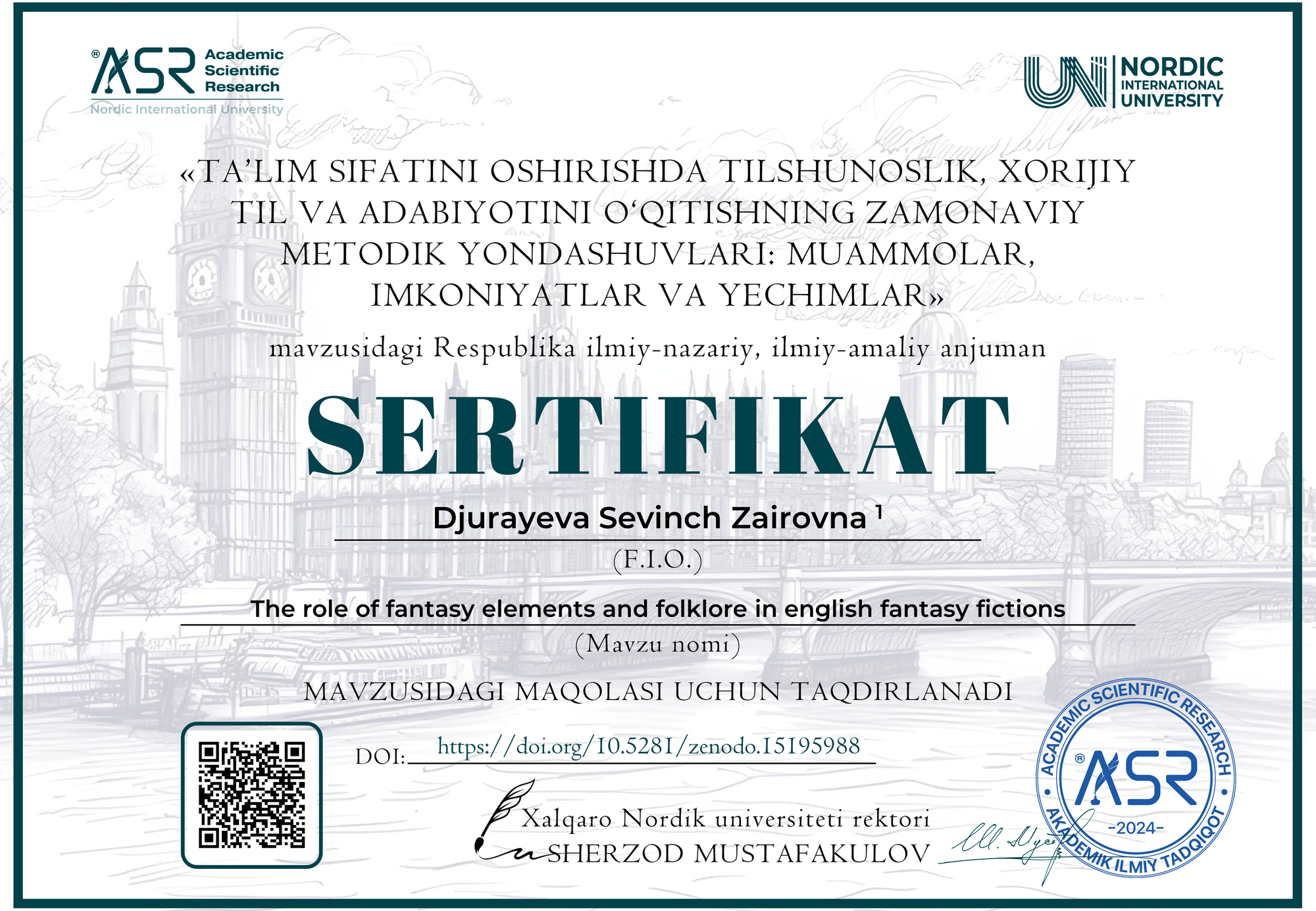Djurayeva Sevinch Zairovna 1

DOI: https://doi.org/10.5281/zenodo.15195988
Google scholar: https://scholar.google.com/scholar?hl=ru&as_sdt=0%2C5&q=%22THE+ROLE+OF+FANTASY+ELEMENTS+AND+FOLKLORE+IN+ENGLISH+FANTASY+FICTIONS%22&btnG=
Zenodo community: https://zenodo.org/records/15195988
Nordic_press journal: https://research.nordicuniversity.org/index.php/nordic/article/view/2339
MAQOLANI YUKLAB OLISH
SERTIFIKATNI YUKLAB OLISH
REVIEW:
Djurayeva Sevinch Zairovna’s article provides an insightful exploration into the intersection of fantasy and folklore within English fantasy literature. The paper emphasizes the profound impact that folklore has had on shaping the structures and themes of the fantasy genre, and the author expertly articulates how these elements are more than just decorative; they play a crucial role in world-building, character development, and thematic depth.
The article presents a thorough historical perspective, tracing the origins of fantasy back to ancient myths, legends, and folklore, and moving through key literary periods, from medieval romances to 19th-century Gothic works, which have laid the foundation for modern fantasy. The author effectively connects these literary traditions to contemporary fantasy giants such as J.R.R. Tolkien and C.S. Lewis, demonstrating how their works have perpetuated and evolved these ancient themes.
In terms of methodology, Zairovna employs a qualitative, text-based analysis of key English fantasy works, grounding her examination in folklore studies, literary criticism, and narratology. This approach allows the author to engage with fantasy elements such as motifs, mythology, world-building, and thematic resonance, providing a nuanced understanding of how folklore is incorporated into these narratives.
The article’s results highlight several critical ways in which folklore contributes to fantasy fiction. First, the role of folklore in world-building is particularly evident in works like Tolkien's The Lord of the Rings, where elements from Norse mythology, Anglo-Saxon lore, and Celtic tales form the foundation of Middle-earth’s rich cultural and historical tapestry. Zairovna also explores how folklore provides authors with a repository of archetypes that inform character development. For example, Neil Gaiman's American Gods uses ancient gods as characters struggling to retain relevance in a modern world dominated by technology.
Additionally, the paper discusses how folklore enables the exploration of universal themes such as good versus evil, identity, and morality. It is noted that folklore often provides a framework for moral ambiguity, as in the complex figures of the Faerie Queen, who embodies both cruelty and kindness, reflecting the unpredictable nature of power. Moreover, Zairovna addresses the role of folklore in shaping magical systems, as seen in works like Susanna Clarke's Jonathan Strange & Mr. Norrell, where magic is deeply intertwined with English history and mythology.
Zairovna's discussion also critically addresses the potential pitfalls in using folklore in fantasy literature. She emphasizes the importance of avoiding appropriation or misrepresentation of cultural narratives, urging authors to engage with folklore in a creative and transformative way rather than merely replicating traditional stories. This caution enhances the relevance of folklore within contemporary discourse, especially in terms of challenging societal norms and addressing modern-day issues.
The article concludes by reiterating that fantasy and folklore are indispensable to the genre, providing not just escapism, but a medium through which complex societal issues and universal themes can be explored. Zairovna's research highlights the dynamic relationship between folklore and fantasy, showcasing how this synergy enriches both the narrative and the thematic complexity of fantasy works.
In conclusion, this article is a commendable addition to the study of English fantasy literature. It provides a comprehensive analysis of how folklore elements are interwoven into fantasy fiction, offering both academic insights and a broader appreciation for the genre's cultural significance. The author’s thoughtful examination of the ways in which folklore and fantasy interact offers valuable perspectives for both literary scholars and fans of the genre.



